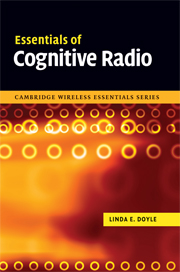Book contents
- Frontmatter
- Contents
- Acknowledgments
- List of abbreviations
- 1 A cognitive radio world
- 2 The essentials – an overview
- 3 Taking action
- 4 Observing the outside world
- 5 Making decisions
- 6 Security in cognitive radio
- 7 Cognitive radio platforms
- 8 Cognitive radio regulation and standardisation
- 9 Conclusions
- Appendix A Developments in the TV white spaces in the USA
- Index
Appendix A - Developments in the TV white spaces in the USA
Published online by Cambridge University Press: 10 August 2009
- Frontmatter
- Contents
- Acknowledgments
- List of abbreviations
- 1 A cognitive radio world
- 2 The essentials – an overview
- 3 Taking action
- 4 Observing the outside world
- 5 Making decisions
- 6 Security in cognitive radio
- 7 Cognitive radio platforms
- 8 Cognitive radio regulation and standardisation
- 9 Conclusions
- Appendix A Developments in the TV white spaces in the USA
- Index
Summary
During the production phase of this book, the FCC released two reports that are of relevance to this book. At that stage it was too late to include details of the reports in the main body of the text. This short appendix addresses the issues briefly.
On 15 October 2008 the FCC released their report (FCC/OET 08-TR-1005) on the Evaluation of the Performance of Prototype TV-Band White Space Devices Phase II. The opening paragraph of the report summarises what the report shows:
The Federal Communications Commission's Laboratory Division has completed a second phase of its measurement studies of the spectrum sensing and transmitting capabilities of prototype TV white space devices. These devices have been developed to demonstrate capabilities that might be used in unlicensed low power radio transmitting devices that would operate on frequencies in the broadcast television bands that are unused in each local area. At this juncture, we believe that the burden of ‘proof of concept’ has been met. We are satisfied that spectrum sensing in combination with geo-location and database access techniques can be used to authorize equipment today under appropriate technical standards and that issues regarding future development and approval of any additional devices, including devices relying on sensing alone, can be addressed.
The report goes on to state that
All of the devices were able to reliably detect the presence a clean DTV signal on a single channel at low levels in the range of – 116 dBm to – 126 dBm; the detection ability of each device varied little relative to the channel on which the clean signal was applied.
- Type
- Chapter
- Information
- Essentials of Cognitive Radio , pp. 229 - 232Publisher: Cambridge University PressPrint publication year: 2009



